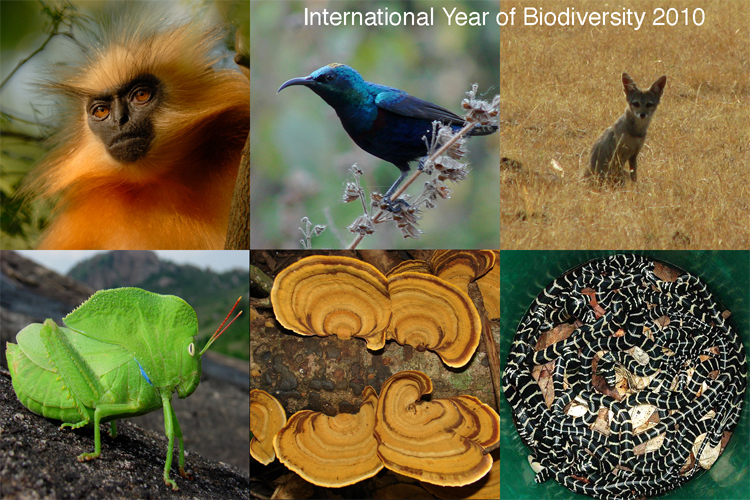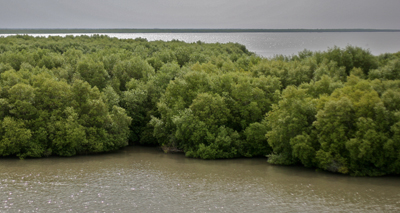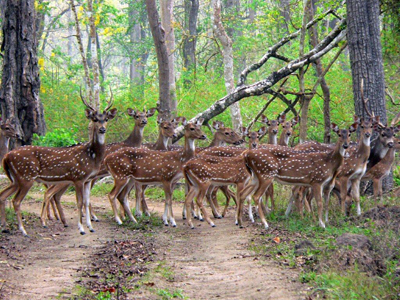International Year of Biodiversity 2010

Photo Credits: Golden Langur: Kalyan Varma; Purple Sunbird, Hooded Grasshopper, Bracket Fungus: Aditya Joshi; Indian Fox: Girish Arjun Punjabi; Baby King Cobras: Jignasu Dolia. Composition: Geoff Hyde
“In 2002, the world’s leaders agreed to achieve a significant reduction in the rate of biodiversity loss by 2010. Having reviewed all available evidence, including national reports submitted by Parties, this third edition of the Global Biodiversity Outlook concludes that the target has not been met. Moreover, the Outlook warns, the principal pressures leading to biodiversity loss are not just constant but are, in some cases, intensifying.”
Ban Ki-moon, Secretary General United Nations, in the Foreword to “Global Biodiversity Outlook 3”, 2010.
2010 is the UN’s International Year of Biodiversity with many celebrations and conferences all around the world aimed at increasing awareness, particularly in the political realm, of the diversity of life on earth and the challenges it faces. One of the most important IYB 2010 projects has been a thorough-as-possible review of the status of the world’s biodiversity. The results of this review were published in the 96 page document, Global Biodiversity Outlook 3, and in a recent report in the journal Science (Global Biodiversity: Indicators of Recent Declines: see Abstract here), with NCBS researcher Suhel Quader as one of the 45 contributing authors.
But if one digs a bit deeper, and especially into the report’s supplementary material, then one finds it is actually even grimmer than that. Basically, while it is true that there is no evidence of improvement, the evidence itself is too meagre in quantity and quality to be able to really tell us whether there has been, overall, either improvement - or deterioration.
The task of determining trends in the state of the world’s biodiversity is much more difficult than, say, determining trends in global warming. The latter, itself viewed by some as a controversial challenge, involves only a single variable: temperature. For biodiversity however, no single measure has been suggested previously, and while the report did attempt to devise one (“aggregated state index”), it suffers from problems with the scope and reliability of its component indicators (see below), and was not emphasised in the paper’s Abstract. It is probably best viewed as a convenient aid to communicating with non-scientists about biodiversity.
What the report did focus on instead was a potentially more meaningful, if less tidy, list of of ten indicators of the state of biodiversity: the idea being to gauge the health of the bigger picture from the health of the details. But this approach had its problems too. First, as stated in the supplementary materials: “no adequate global indicators are available for additional key aspects of biodiversity, including: invertebrate, fungi and plant trends; grassland and wetland extent; habitat condition; primary productivity, wild genetic diversity; freshwater and terrestrial trophic integrity; ecosystem functioning.” Moreover, for the 10 indicators that were used: “Taking into account the various limitations of the underlying datasets, we judged indicator reliability to be…10%”, i.e. only a single indicator was considered reliable. This is not to downplay the enormous amount of effort that has gone into collating the data that is available. As Suhel Quader says: "Hidden behind the various indices are millions of person-hours of work over the years. This includes work done by biodiversity and conservation professionals, of course -- but for many indices most of the field data has been collected by tens of thousands of passionate and committed volunteers: amateurs from across the globe counting birds, butterflies, bats and other plants and animals year after year."
So what does it all mean? Well, while there are not yet any unequivocal statistics that capture the state of the world’s biodiversity, the very absence of the data that might help us to find such statistics is telling. If no-one is watching the shop, it’s a safe bet it is being looted. But that itself is not unexpected: the widespread realisation that the shop is worth watching - that biodiversity is important to humanity’s long-term well-being - is relatively recent.
Luckily, it is an idea that has caught on quickly: since the Convention for Biological Diversity was first adopted at the 1992 Rio Summit, it has been signed by 193 countries, and national biodiversity strategies and action plans are in place in over 170. So why is all this potentially useful activity, occurring around the world, not having major results? One reason is, according to Global Biodiversity Outlook 3, is that: “while the activities of environmental departments and agencies in tackling specific threats to species, and expanding protected areas, has been and continues to be extremely important, they are easily undermined by decisions from other ministries that fail to apply strategic thinking on policies and actions that impact on ecosystems and other components of biodiversity.”
And that is where the International Year of Biodiversity 2010 can play such a big role. The world now realises biodiversity is important, it just does not realise how important. Raising awareness through conferences and general educational activities is critical to making it easier for politicians to implement what might otherwise be viewed as electorally unpleasant policies. At the heart of the matter, as Global Biodiversity Outlook 3 puts, it is the need for “pricing, fiscal policies and other mechanisms to reflect the real value of ecosystems, (so that) powerful incentives can be created to reverse patterns of destruction that result from the undervaluation of biodiversity.”
Some useful links:
Butchart et al (2010) Global Biodiversity: Indicators of Recent Declines. Science, 328, 1164 - 1168
Full copy of Global Biodiversity Outlook 3
IYB 2010 activities in India
Achieving 2010 biodiversity target: India’s contribution
Kalyan Varma's Wildlife Photography





Comments
Post new comment